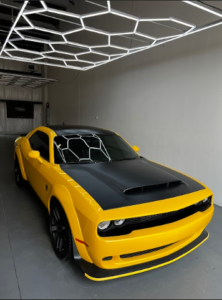In the world of automobiles, beauty is more than skin deep. The skin – or, The paintwork – plays a significant role in how we perceive a vehicle’s beauty and value. Exposure to the elements, minor accidents, or daily wear and tear can rob a vehicle of its original luster. But all is not lost. There’s an unsung hero in the realm of auto detailing who can restore your car’s paintwork to its former glory and beyond. This hero is known as paint correction, a transformative procedure that breathes new life into your vehicle’s appearance. Let’s embark on a journey to understand the power and process of paint correction.
Understanding Paint Correction
The painstaking procedure of repairing and revitalizing a vehicle’s paintwork is known as paint correction. It entails removing surface flaws that interfere with a genuine and correct, clean, sharp reflection by reflecting light off in different directions and dulling, oxidizing, or hazing the surface. These flaws include bird-dropping etching and acid rain etching, hologramming and buffer trails, random isolated deep scratches (or RIDS), and fine swirl marks and scratches.
Think about a vehicle you’ve seen that sparkles in the sunlight, almost like a mirror. That high-gloss finish is often the result of paint correction Asheville NC. It’s more than a quick fix; it’s a transformation that can make an older car look like it just rolled off the assembly line.

The Importance of Paint Correction
Paint correction is not just about aesthetics; it’s also about preserving the longevity of your vehicle’s paintwork. Without correction, imperfections can worsen over time, leading to further oxidation and eventual clear coat failure. A properly corrected and protected paintwork will last for years, maintaining the vehicle’s aesthetic appeal and resale value.
For instance, consider a car with a vibrant red paint job. The sun’s UV rays can cause the color to fade to a dull pink. But through paint correction, the rich, vibrant red can be restored, giving the car a like-new appearance and protecting the paintwork from future damage.
The Process of Paint Correction
The process of paint correction is a labor-intensive one, requiring skill, precision, and an understanding of different paint compositions. It generally involves three key stages: assessment, correction, and protection.
In the assessment stage, the detailer meticulously examines the vehicle’s paint to identify all existing imperfections. This could be compared to a doctor diagnosing a patient before commencing treatment.
The correction stage is where the magic happens. Using specialized tools and techniques, the detailer carefully removes or minimizes imperfections, restoring the paintwork’s smoothness and clarity. Like a sculptor shaping a masterpiece from raw stone, this stage requires patience, skill, and an artist’s touch.
The protection stage involves sealing the freshly corrected paintwork with a suitable product like wax or ceramic coating. This step is akin to applying sunscreen to protect your skin from harmful UV rays.

Paint Correction vs. Traditional Washing
It’s important to distinguish between paint correction and traditional washing. While both are integral parts of auto detailing, they serve different purposes.
Traditional washing focuses on removing dirt, dust, and grime from the vehicle’s surface. It’s like taking a shower; it cleans the skin but doesn’t address deeper issues like scars or blemishes.
Paint correction is like a visit to a dermatologist. It deals with deeper, underlying issues that affect the health and appearance of the skin—or, in this case, the vehicle’s paintwork.
Tools of the Trade
A detailer employs a variety of tools for paint correction. These may include rotary polishers, dual-action polishers, sanding papers, compounds, and polishes, among others.
Each tool serves a specific purpose and requires a trained hand to wield effectively. A rotary polisher, in skilled hands, can quickly remove paint defects and leave a highly polished finish. Incorrect use can lead to further damage, highlighting the importance of professional expertise in paint correction.
Time and Patience: Key Ingredients of Paint Correction
One of the most crucial aspects of paint correction is time. Unlike a regular wash and wax, which can be completed in a few hours, paint correction is a meticulous process that can take anywhere from a day to a week, depending on the severity of the paint defects and the size of the vehicle.
This isn’t a process that should be rushed. Like a fine wine, a beautifully corrected vehicle takes time—a testament to the detailer’s skill and patience.
Maintaining Corrected Paintwork
After investing time and resources in paint correction, it’s essential to maintain the corrected paintwork properly. This includes regular washing using proper techniques, avoiding automatic car washes that can inflict scratches, and regularly applying a quality sealant or wax to protect the paintwork.
Think of it as a fitness regimen for your car. Just as you’d nourish and exercise your body after a medical procedure, your vehicle requires ongoing care to keep its newly revived paintwork in peak condition.
Paint correction is a powerful, transformative process in the world of auto detailing. It goes beyond superficial cleaning to address the root causes of paintwork imperfections, restoring vehicles to their former glory or even surpassing it. Like any worthwhile endeavor, car detailing Asheville NC paint correction requires time, patience, and an expert’s touch. If your vehicle’s paintwork has lost its luster, consider paint correction. It could be the makeover your car needs to shine once again.
Frequently Asked Questions
What is Paint Correction?
In the auto detailing process, known as paint repair, surface flaws in a car’s paint are eliminated. These flaws could be different environmental factors, such as oxidation, swirl marks, deeper scratches, and other blemishes that detract from the aesthetic of the car.
How Does Paint Correction Work?
The process of paint correction begins with a thorough cleaning of the vehicle’s exterior to remove loose dirt and debris. The detailer uses professional tools and products to gently remove or minimize the surface imperfections. A protective product like wax or ceramic coating is applied to seal the corrected paintwork.
How Long Does Paint Correction Take?
Depending on the extent of the paint flaws and the size of the vehicle, the paint correction procedure’s length can change. It could take a day or perhaps a week.
Is Paint Correction a One-Time Process?
While paint correction can dramatically improve the appearance of your vehicle, it doesn’t make it immune to future damage. Regular washing and maintenance are essential to keep the paintwork looking its best.
Can I Do Paint Correction Myself?
While there are DIY paint correction kits available, the process requires a certain level of skill and expertise. Incorrect techniques can lead to further damage. It is recommended to have paint correction done by a professional auto detailer.
Does Paint Correction Remove All Scratches?
Paint correction can remove or minimize most minor scratches and swirl marks. Deep scratches that have penetrated the clear coat may not be fully correctable through this process.
How Often Should I Have Paint Correction Done?
This depends on various factors, such as the vehicle’s exposure to the elements, how often it’s driven, and personal preference. It is beneficial to have paint correction done every one to two years to maintain the vehicle’s appearance.
Is Paint Correction Worth the Cost?
Yes, if you value the aesthetic appeal of your vehicle and want to maintain its resale value. A well-executed paint correction can make an older car look brand new again.
Can All Cars Benefit from Paint Correction?
Almost all cars can benefit from paint correction, regardless of their age or condition. The results are particularly noticeable on vehicles with darker paint colors, as they show imperfections more easily.
